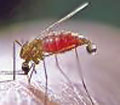
One can expect a good news on the front of treatment of malaria as a possible new optical imaging system may make the diagnosis of malaria a lot easier, speedier and precise, a new study has suggested.
The new system to diagnose malaria has been developed by an international team of researchers. The team has employed "speckle imaging," an optical sensing technique that calculates the differences in how laser light bounces off the membranes of healthy and infected red blood cells.
A clear statistical pattern becomes evident by comparing the apparently random scattering (speckling) of light as it builds up from multiple images, it helps identifying cells that nurtures the parasite responsible for malaria.
The preliminary results given by the researchers were based on 25 cell samples (12 healthy, 13 infected).
"A new diagnostic tool is urgently needed," Dan Cojoc, Ph.D., lead author of the study and a researcher at the Materials Technology Institute, National Research Council in Trieste, Italy has been quoted as saying.
"With a fast, portable, low-cost, and accurate diagnostic tool, physicians can confidently and quickly administer the correct therapy."
As per the team of researchers, this timely diagnosis increases the chances of successful, life-saving treatment. It also reduces the possibility that inappropriate therapy will be given, which would help fight the growing problem of malaria with drug resistance.
The present diagnostic gold standard for malaria, Giemsa-stained blood smear, employs optical microscopy to detect different species of the malaria agent, Plasmodium, in blood samples.
For the use of this technique skilled medical professionals required who are trained to detect the telltale signs of the parasite throughout its life cycle and its density in the bloodstream.
In order to find a more suitable means of detection, Cojoc's team of biophysics researchers in Italy teamed up with malaria experts from Israel and Spain.
The collaboration turned to speckle imaging, because it was handy to construct a statistically significant picture, as a new way to better the diagnosis of malaria. The system is given the name speckling due to light's wave-like ability to brighten as waves combine and fade as they cancel. This makes a distinctive speckled pattern.
The particular technique used by the researchers is called Secondary Speckle Sensing Microscopy.
With use of this imaging technique to an automated high-throughput system, the researchers became able to get results in as fast as 30 minutes.
The researchers did so with an increased rate of accuracy and without having highly trained technicians and a highly advanced hospital laboratory. The research is path breaking as present time to diagnosis in most African medical centers is typically between 8-10 hours.
Secondary Speckle Sensing Microscopy starts with illuminating red blood cells with an inclined laser beam. This creates a time-varied speckle pattern field based on the cells' thermal vibration and the movement of their membranes – characteristics that vary in healthy and diseased conditions.
The speckle patterns are examined under the microscope and recorded on a camera at a high frame rate.
With the use of dual automated analytical methods - "fuzzy logic" and "principal component analysis" - scientists scour a set of speckle parameters to deduce statistical information about changes in red blood cells' membranes and their flickering movements.
Researchers then make a diagnosis on the basis of statistical correlations in speckle patterns between healthy and diseased cells.
Researchers found these preliminary results encouraging, they also observed that further research is required to authenticate the results and further improve the technique. If the results are positive, field studies or clinical trials of the new method might be started as early as 2013.
The findings of this research are published in the Optical Society's (OSA) open-access journal Biomedical Optics Express.
--with inputs from ANI
|
|
Read More: Israel | Italy | Central African Republic | Mobile Technology | Technology Bhawan | J.j.hospital | S.v.medical College So | Agricultural Research Centre | Karnata Health Institute | Central Leather Research Insti | Indian Institute Of Technology | Govt.college Of Technology | Council House Street | Indian Research Po | K.m.hospital | S.d.hospital | Kharagpur Technology So | Haringhat River Research Insti | Rubber Research Station | K.r.high School


Comments: